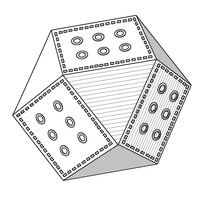
Viking Designs
Drawing of a Polyhedral Weight
This drawing is of a polyhedral weight of a type that the Vikings adopted from Middle Eastern cultures and brought back to Europe with them. These weights are very common on Viking Age sites.
Read More
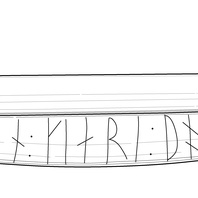
Viking Designs
Drawing of the Thorfast Comb Case
A bone comb case with a runic inscription which reads ‘Thorfast made a good comb’. It is unknown whether the runes were inscribed by Thorfast himself as advertising, or whether the owner inscribed them to remind them where to go for another good comb if they needed one.
Read More
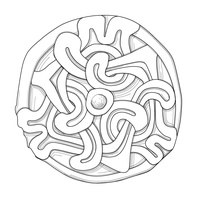
Viking Designs
Drawing of Copper Alloy Disc Brooch
Drawing of a copper alloy, gilded brooch with a zoomorphic design. Brooches were a typical part of female dress. Scandinavian brooches came in a variety of sizes and shapes which included disc, trefoil, lozenge, equal-armed, and oval shapes. The different brooch types served a variety of functions in Scandinavian female dress with oval brooches typically being used as shoulder clasps for apron-type dresses and the rest being used to secure an outer garment to an inner shift. Anglo-Saxon brooches do not match this diversity of form with large disc brooches being typical of ninth century dress styles with smaller ones becoming more popular in the later ninth and tenth centuries. However, since disc brooches were used by both Anglo-Saxon and Scandinavian women they are distinguished by their morphology. Scandinavian brooches were typically domed with a hollow back while Anglo-Saxon brooches were usually flat. Moreover, Anglo-Saxon brooches were worn singly without accompanying accessories.
Read More
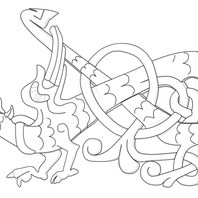
Viking Designs
Drawing of Detail from the Southwell Lintel
The lintel above a door in Southwell Minster features the Archangel Michael fighting off a Norse-style ribbon beast. This drawing shows a detail of the ribbon beast. The lintel is probably an eleventh-century grave cover that was recarved and decorated in the twelfth century and placed into a new position.
Read More
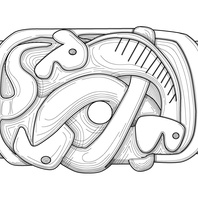
Viking Designs
Drawing of an Urnes-Style Mount
A drawing of a cast copper alloy sword fitting with Urnes-style decoration.
Read More
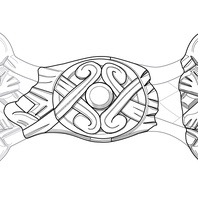
Viking Designs
Drawing of an Equal-Armed Brooch
Drawing of a Viking Age equal-armed brooch based on fragments found at Harworth Bircotes, Nottinghamshire and reconstructed based on parallels from Birka, Sweden. For more information on Scandinavian jewellery in England check out our blog: Brooches, Pendants and Pins: Scandinavian Dress Accessories in England.
Read More
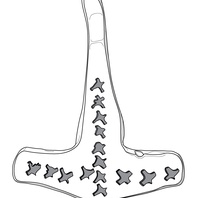
Viking Designs
Drawing of a Hammer-Shaped Pendant
A drawing of a gold hammer-shaped pendant, popularly called a Thor’s hammer pendant, from Spilsby, Lincolnshire. These may have been worn to show devotion to the god Thor, or to secure the god’s protection, although there is little evidence to support this interpretation. Pendants like this have been found made of lead, copper alloy, silver and gold, showing that many different strata of society could have worn them.
Read More
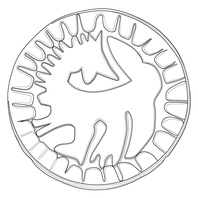
Viking Designs
Drawing of a Brooch with Backwards-Facing Beast
Drawing of a disc brooch found at South Ferriby, Lincolnshire with a backwards-facing beast motif. For more information on Scandinavian jewellery in England check out our blog: Brooches, Pendants and Pins: Scandinavian Dress Accessories in England.
Read More
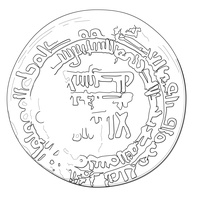
Viking Designs
Drawing of an Arabic Coin
Drawing of an Arabic silver dirham minted in the Middle East and probably brought to Lincolnshire by Viking traders. The dirham was a unit of weight used across North Africa, the Middle East, and Persia, with varying values which also referred to the type of coins used in the Middle East during the Viking Age. These coins were extremely prized possessions not only for their silver value but as a way of displaying one’s wealth and vast trade connections. Millions of Arabic Dirhams would have been imported throughout the Viking world and are mostly found in hoards. Arabic dirhams demonstrate contact between the Viking diaspora and the Arabic world. Arabic coins are especially useful for dating sites, because they carry the date when they were minted. This permits precise dating where the part of the coin with the date survives, whereas European coins can only be dated to the reign of the ruler depicted on them. In western descriptions of these coins, the Arabic dates found on the coins are usually listed in square brackets, as above, and the European equivalent is listed after it.
Read More
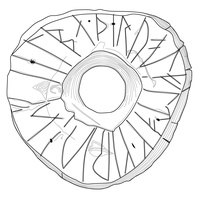
Viking Designs
Drawing of the Saltfleetby Spindle Whorl
Drawing of a lead alloy spindle whorl from Saltfleetby, Lincolnshire showing part of the runic inscription. For further information, see the entry for the original item.
Read More
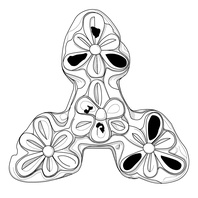
Viking Designs
Drawing of a Carolingian Trefoil Mount
Drawing of a copper alloy and gilded Carolingian mount with niello inlay found in Leicestershire. The mount has holes drilled through it for affixing to a surface, possibly a book, or perhaps to repurpose it as a pendant.
